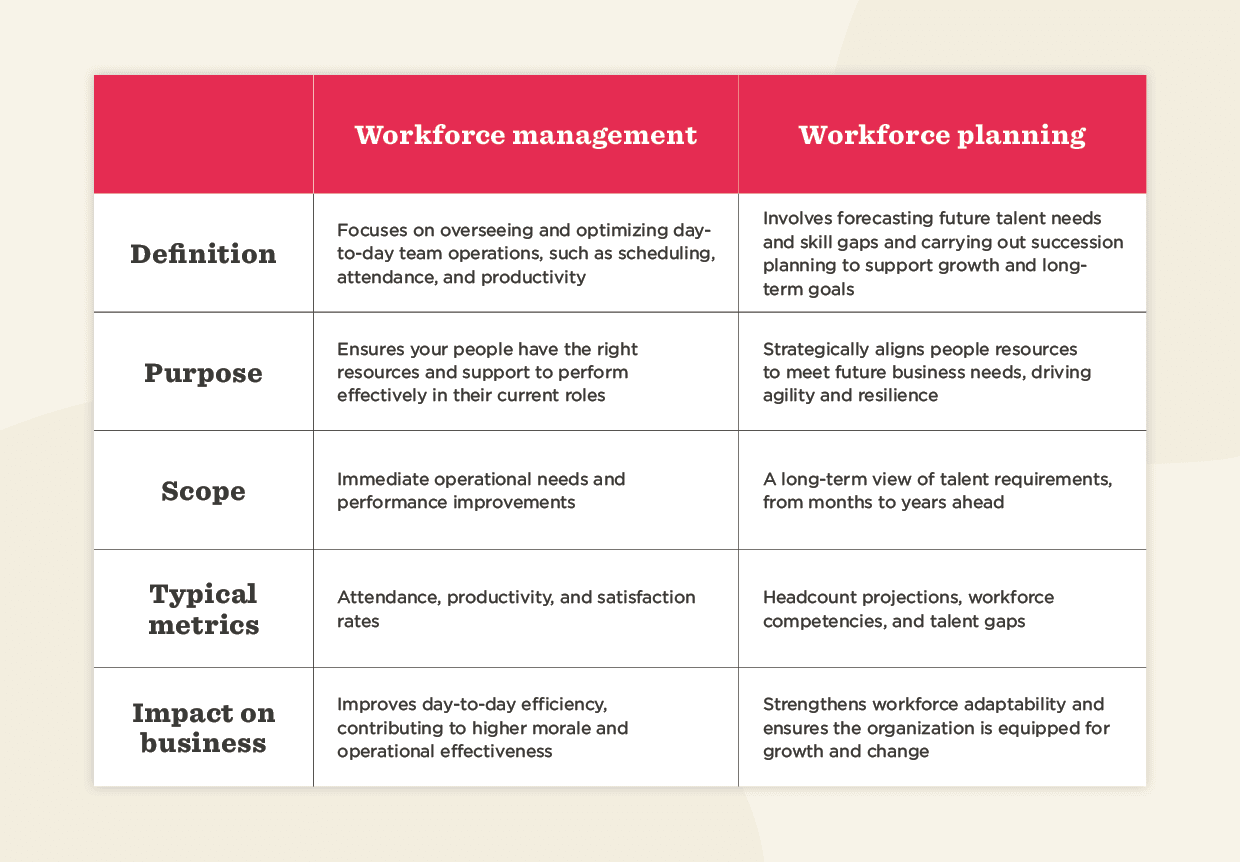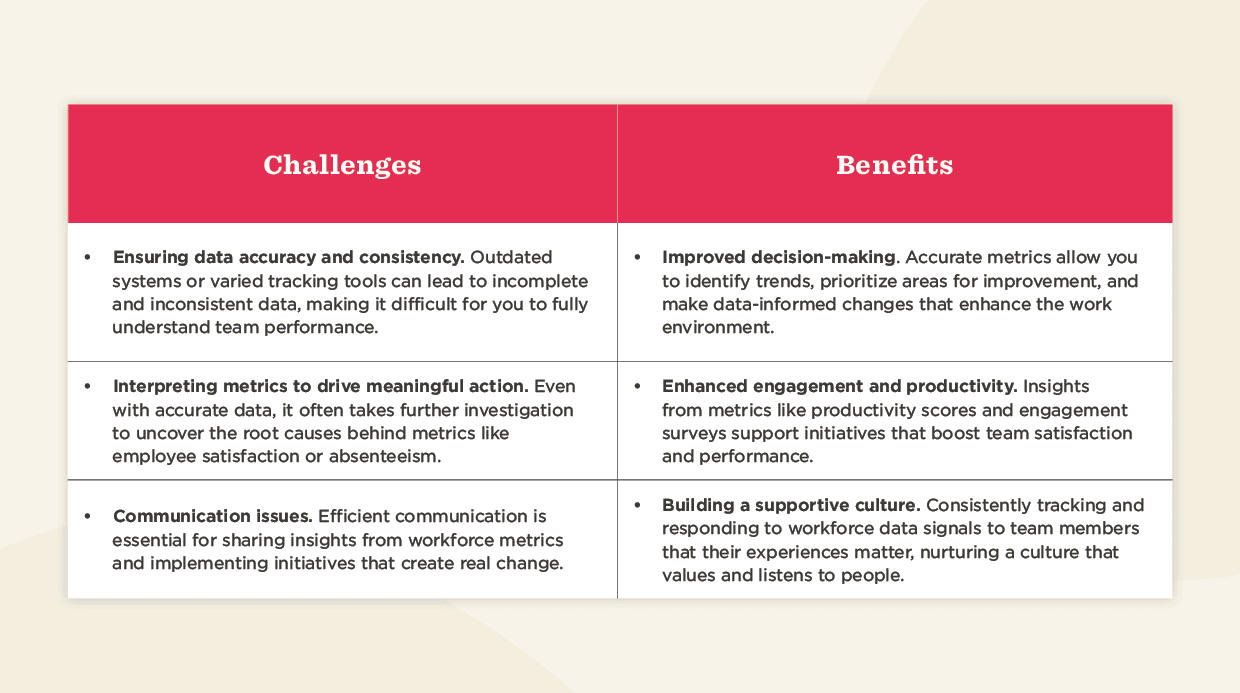What if you could instantly know your team’s needs, fine-tune productivity, and clearly show the value of your workforce management strategies?
Workforce management (WFM) metrics have the power to help you with all this and more, giving your HR team the data they need to make confident, forward-thinking decisions.
In this article, we’ll explore the essential WFM metrics you can use to measure, optimize, and communicate the effectiveness of your people programs. These tools can help you build a data-driven HR strategy by providing a clearer view of what’s working and what needs attention. They’re fundamental to building a resilient and engaged workforce that fuels your organization’s success.
What is workforce management vs. workforce planning?
Before diving into specific metrics, it’s helpful to know the difference between workforce management and workforce planning:

In short, workforce management is about optimizing today, while workforce planning is about preparing for tomorrow.
What are workforce management metrics vs. workforce planning metrics?
To build a data-driven HR strategy, it’s helpful to distinguish between workforce management metrics and workforce planning metrics. They each serve different purposes and produce unique outcomes.
Workforce management metrics focus on monitoring and improving the present-day operations of your team. They provide a snapshot of current performance, engagement, and efficiency, allowing you to make quick, responsive decisions that directly impact daily operations.
Workforce planning metrics, on the other hand, focus on looking ahead and aligning HR strategies with the organization’s future needs. These metrics center around forecasting, talent gaps, succession, and readiness to meet long-term goals.
By leveraging both types of metrics, you can equip your HR team to drive short-term success while also building a resilient foundation for sustainable growth.
Tracking workforce management: Challenges and benefits

Recommended For Further Reading
9 workforce management metrics for achieving operational excellence
To drive a high-performing, engaged workforce, it’s important to gauge how well teams are functioning and identify areas for growth—and that’s where the right metrics can help.
Below are some key workforce management KPIs to track to help your organization achieve operational excellence:
1. Absenteeism
The absenteeism rate reveals how often team members are unexpectedly absent from work. High absenteeism can signal potential challenges with wellbeing, workload, or morale. By monitoring absenteeism, you can detect trends, like seasonal spikes or team-specific issues, and proactively address the root causes through supportive initiatives like wellness programs or workload adjustments.
2. Turnover rate
The turnover rate tracks the percentage of people leaving the organization over a specific period, providing insights into retention and overall satisfaction. Monitoring turnover can help you identify patterns and develop strategies that improve retention—such as career development programs, improvements to workplace culture, or better compensation packages.
3. Productivity
Tracking productivity is a way of measuring workforce performance, giving you insights into how efficiently people meet targets, handle tasks, or complete projects. This data can help you understand where bottlenecks may exist and which areas might benefit from additional support.
4. Time-to-productivity
This metric measures how quickly new team members reach full productivity in their roles. Time-to-productivity reflects the effectiveness of onboarding processes and how well new hires integrate into the team.
This metric allows you to fine-tune onboarding processes, ultimately enhancing operational efficiency and maximizing the value that new hires bring to your organization.
5. Overtime hours
While occasional overtime is natural, high levels can contribute to burnout and decreased productivity in the long term. By identifying overtime trends, you can address workload issues and ensure a healthier, more sustainable balance for your people.
6. Employee satisfaction index (ESI)
The ESI measures general job satisfaction by asking team members three simple questions:
- How satisfied are you with your current workplace?
- How well does your current workplace meet your expectations?
- How close is your current workplace to your ideal job?
The ESI provides a broad view of satisfaction. By tracking ESI, you can identify patterns and proactively address concerns, improving overall morale and retention.
7. Utilization rate
Utilization rate measures how effectively team members spend their time on productive tasks. It provides insights into workload balance and time management, demonstrating whether your organization is underutilizing or overburdening certain people.
High utilization suggests efficiency, while low utilization may indicate a need for role restructuring or additional tasks.
8. Time allocation by task
Time allocation by task reveals how team members divide their time across various responsibilities. This metric helps ensure your people are focusing on high-impact work rather than low-priority or administrative tasks, boosting efficiency as a result.
9. Error rate
Error rate measures the frequency of mistakes or quality issues in a team’s work output. Monitoring the error rate allows managers and your HR team to identify areas where additional training or clearer instructions are necessary. A lower error rate usually brings with it higher productivity and overall quality, directly supporting operational goals.
How to improve workforce management with an HCM
Tracking the right HR metrics for workforce optimization is essential for ensuring effective, thriving, and resilient teams within your organization—and a human capital management (HCM) system is the backbone of this approach.
By centralizing all workforce data, an HCM allows you to access real-time insights into attendance, engagement, productivity, and more, ensuring data is accurate, actionable, and easy to analyze.
With automated tracking of key metrics, you can identify trends and respond to them proactively, whether it’s an uptick in absenteeism, changes in engagement, or the need for adjustments in scheduling to support work-life balance. You’ll also have the data you need to convince key stakeholders to support new people-first initiatives.
With data-driven workforce management, your HR team will be able to put people programs in place that truly make a difference, maximizing the effectiveness of your current workforce and setting your organization up for long-term success.


